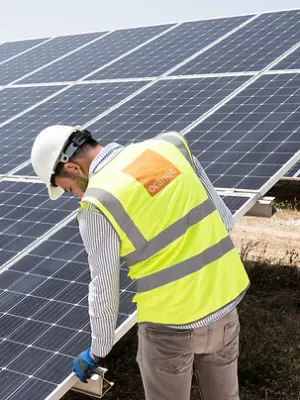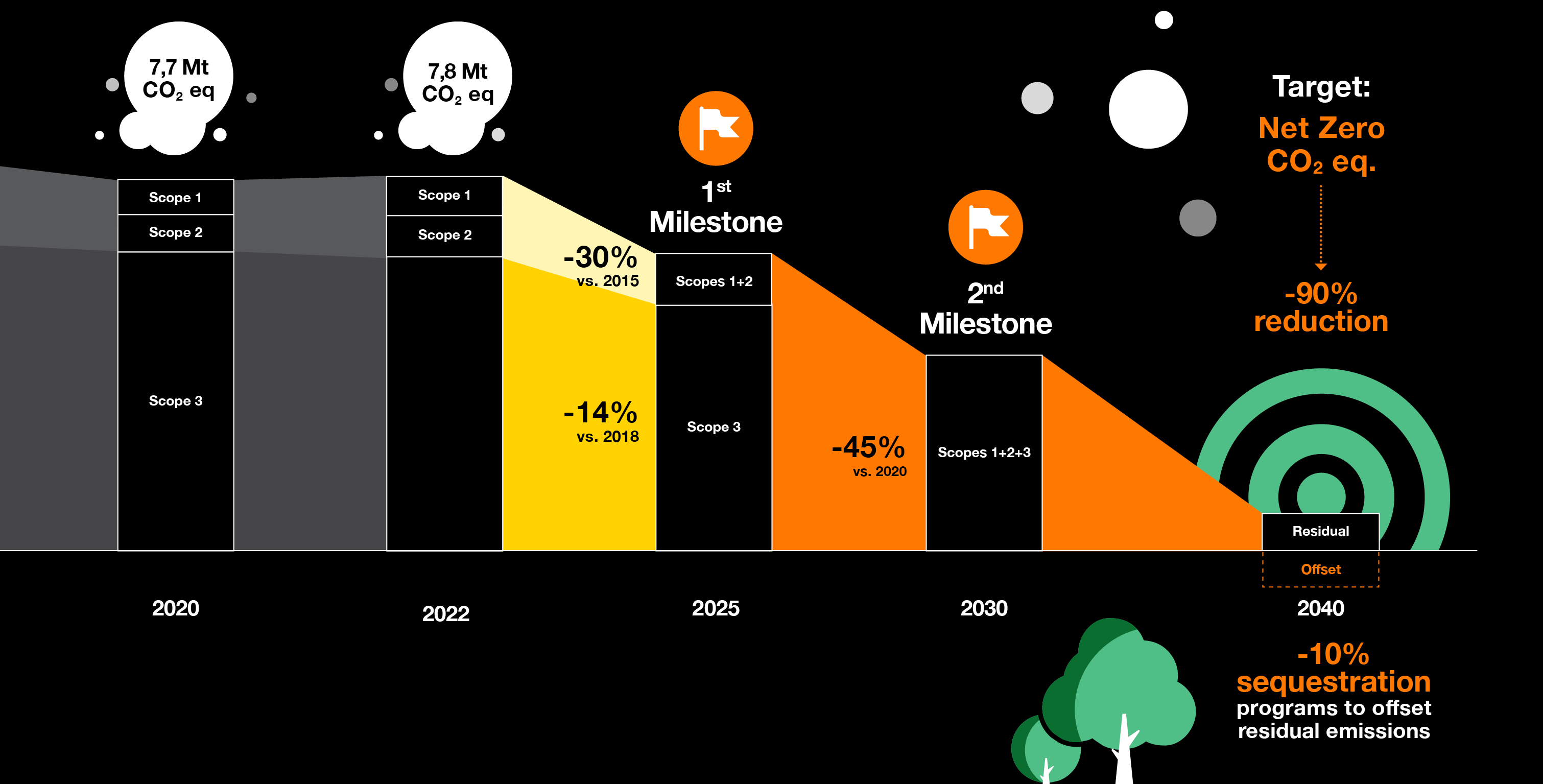Reducing our carbon footprint is central to our environmental commitment. Because scope 3 represents more than 80% of our carbon footprint, we’re strengthening our efforts to reduce our greenhouse gas emissions linked to our value chain, i.e. the CO₂eq emissions from suppliers, service providers, and customers.
Our target: Net Zero Carbon emissions by 2040
Orange is targeting Net Zero Carbon emissions by 2040, which means reducing CO2eq emissions by 90% and implementing carbon sequestration programs to offset the rest. We’re already seeing concrete impacts – for example, our scope 1 and 2 emissions (related to energy consumption) fell by 38.6% in 2024 compared to 2015 – thanks to numerous initiatives implemented in recent years, particularly network/IS energy efficiency and accelerating the share of renewable energies in our energy mix.
Working out our carbon footprint
To achieve our Net Zero Carbon ambition, two interim targets have been set for 2025.
- 30%
reduction in our scope 1 and 2 CO₂eq emissions
compared to 2015
- 14%
reduction in our scope 3 CO₂eq emissions
compared to 2018
- Le scope 1 concerns our direct greenhouse gas emissions such as the fossil fuels used in our vehicles, heating, or generators.
- Le scope 2 concerns our indirect emissions such as the electricity we purchase to power our operations (grids and IS, buildings, etc.).
- Le scope 3 concerns all other indirect emissions
- “Upstream” emissions, relating to the products and services we purchase from our suppliers and service providers, as well as waste management, subcontracted activities, and logistics activities.
- “Downstream” emissions, such as delivering or distributing our products and services, and their ongoing use by our customers.
Scope 3 is where Orange has the greatest impact: in 2024, it accounted for 81% of our greenhouse gas emissions,
Reducing scope 3: an action plan that covers our entire value chain
Giving mobile devices a second life
Device manufacturing makes up a major part of the digital sector’s environmental impact. That’s why we encourage the recycling and refurbishment of mobile devices, in particular through our “Re” program . In 2023, our European countries recorded a collection rate of 25.4% of used mobiles. We’re targeting 30% by 2025, a figure already reached in France. What’s more, we’re selling more refurbished devices, and these now represent more than 5% of our sales in France.
Designing greener products and services
Eco-designing a product reduces its environmental footprint over its entire lifecycle. By 2025, all our products sold under the Orange brand will follow this approach, such as the Livebox 7, launched at the end of 2023 and certified by Bureau Veritas. Not only does it incorporate recycled materials, but it is also more energy efficient to run. At the beginning of 2024, we also launched a circular economy initiative to help companies reduce the carbon footprint of their mobile fleet through a calculation method certified by AFNOR.
Focusing on own network equipment
Our network equipment also follows circular economy principles. In December 2020, we launched an Oscar (Orange Sustainable & Circular Ambition for Recertification) program to promote the refurbishment, reuse, and resale of technical equipment to extend its lifespan, with 725,000 pieces of equipment purchased or resold via this marketplace to date. We also share our mobile networks with other operators, limiting the need to build new infrastructure. At the end of 2024, 65% of Orange radio sites were shared, both in terms of infrastructure and energy supply.
Sharing our commitment
We actively seek to work with suppliers who share our environmental values: 20% of the overall score awarded to potential suppliers in our network and IS calls for tenders relate to CSR criteria.
Combined with our efforts on our scopes 1 and 2, this approach – and all those yet to be invented – should enable us to reduce our greenhouse gas emissions by 90% by 2040 to meet our Net Zero Carbon target.
To sequester the remaining 10% CO2eq, we finance – directly or through our Orange Nature fund – natural carbon sink projects, such as mangrove restoration in Cameroon and reforestation in France .
Our GHG emissions reduction trajectory, assessed and validated by the Science Based Targets initiative (SBTi)
CO₂eq or CO₂?
CO2 refers to a single greenhouse gas, carbon dioxide, while CO2eq (or carbon dioxide equivalent) is a unit that measures the emissions of all greenhouse gases on the basis of their “global warming potential” (GWP).
Our key figures
Orange’s carbon footprint in 2022
≈ 5,4 Mt eq. CO₂
Breakdown of our carbon footprint:
Scope 1
6,5%
Scope 2
12,5%
Scope 3
81%
Reduction in scope 1 and 2 emissions since 2015
- 38.6%


